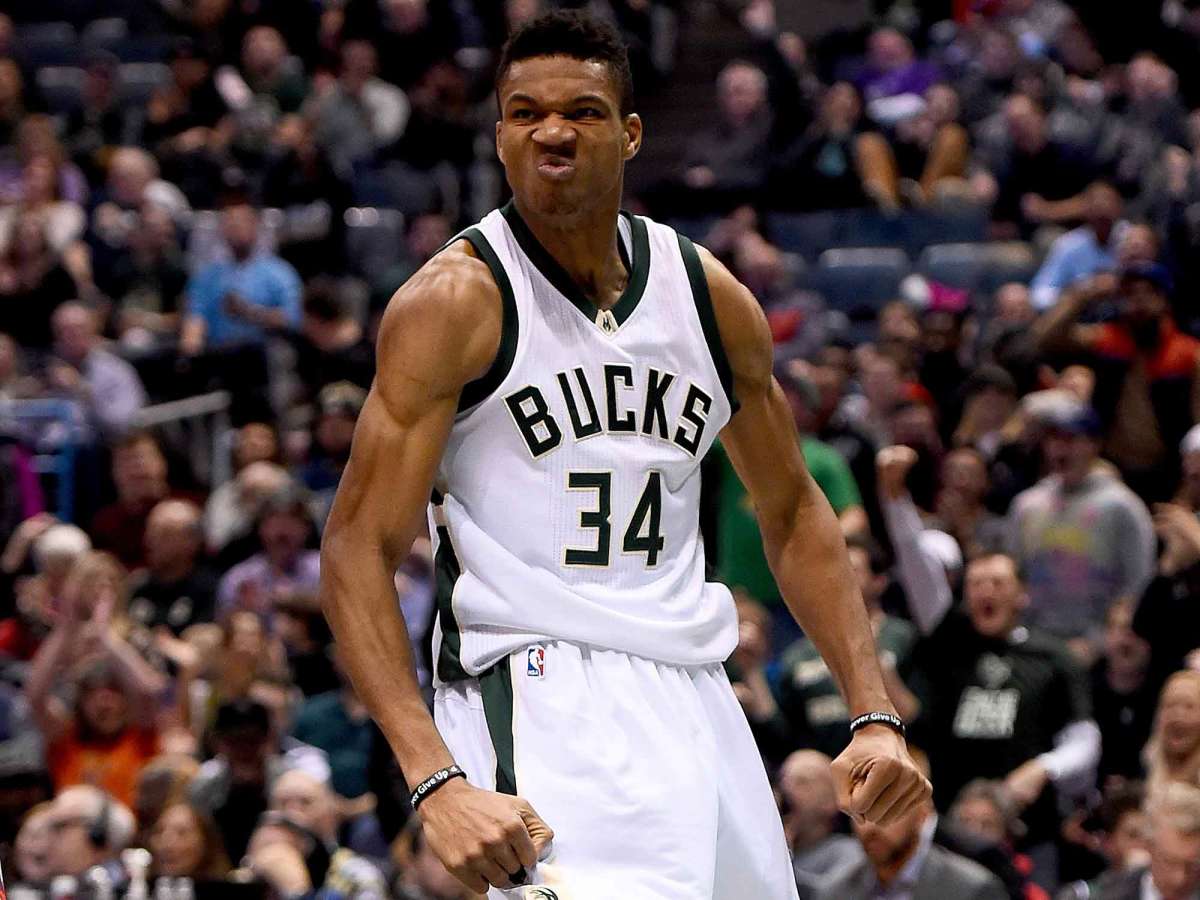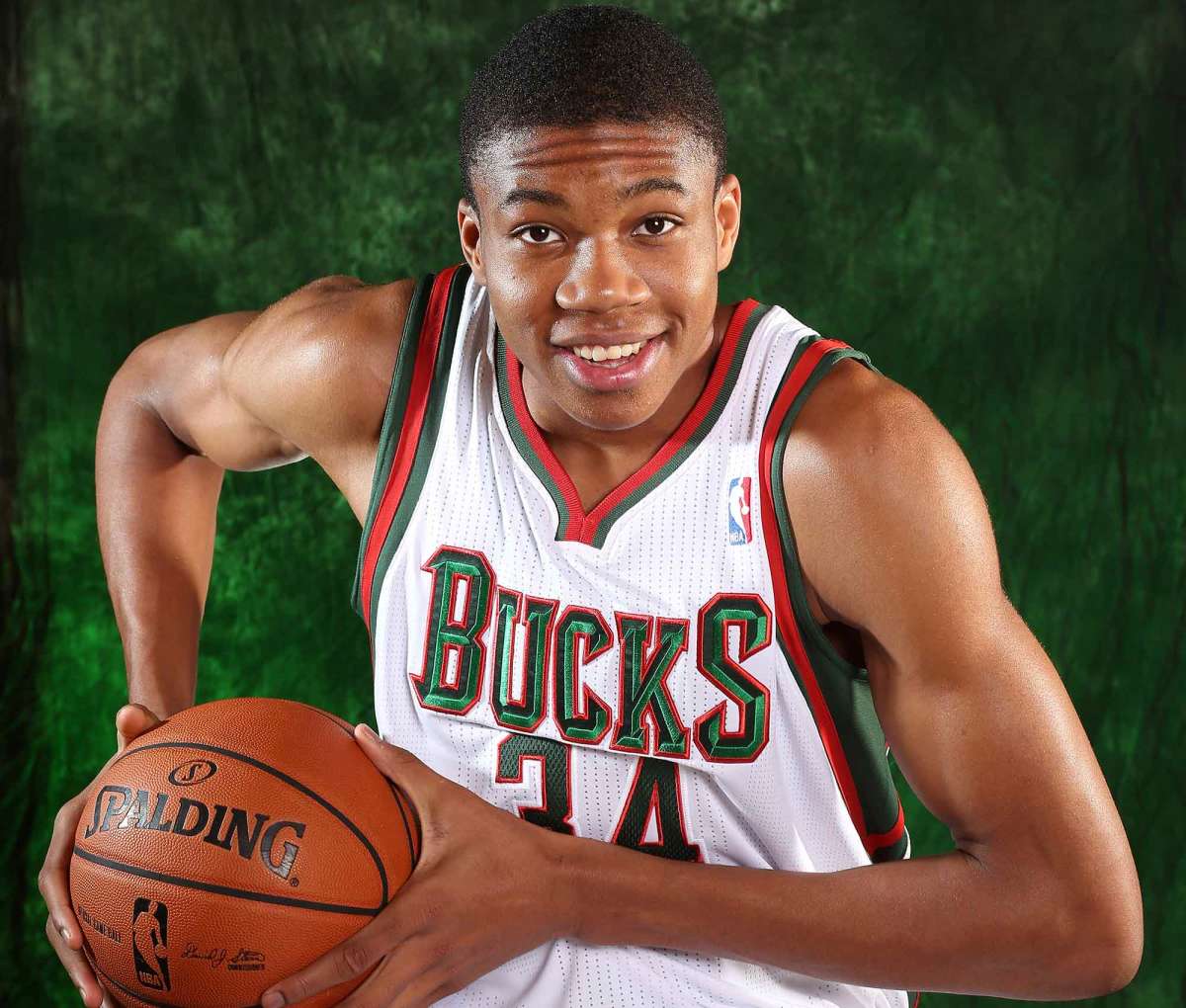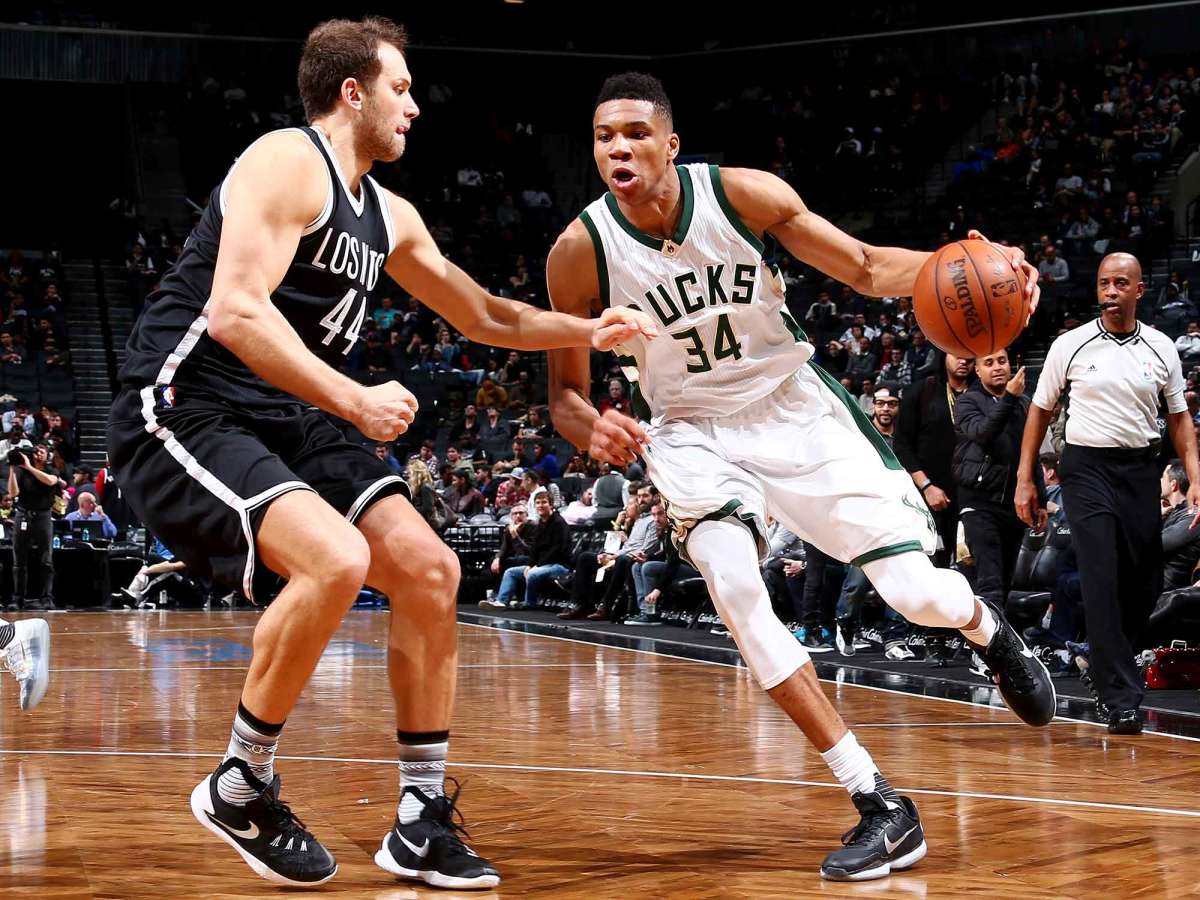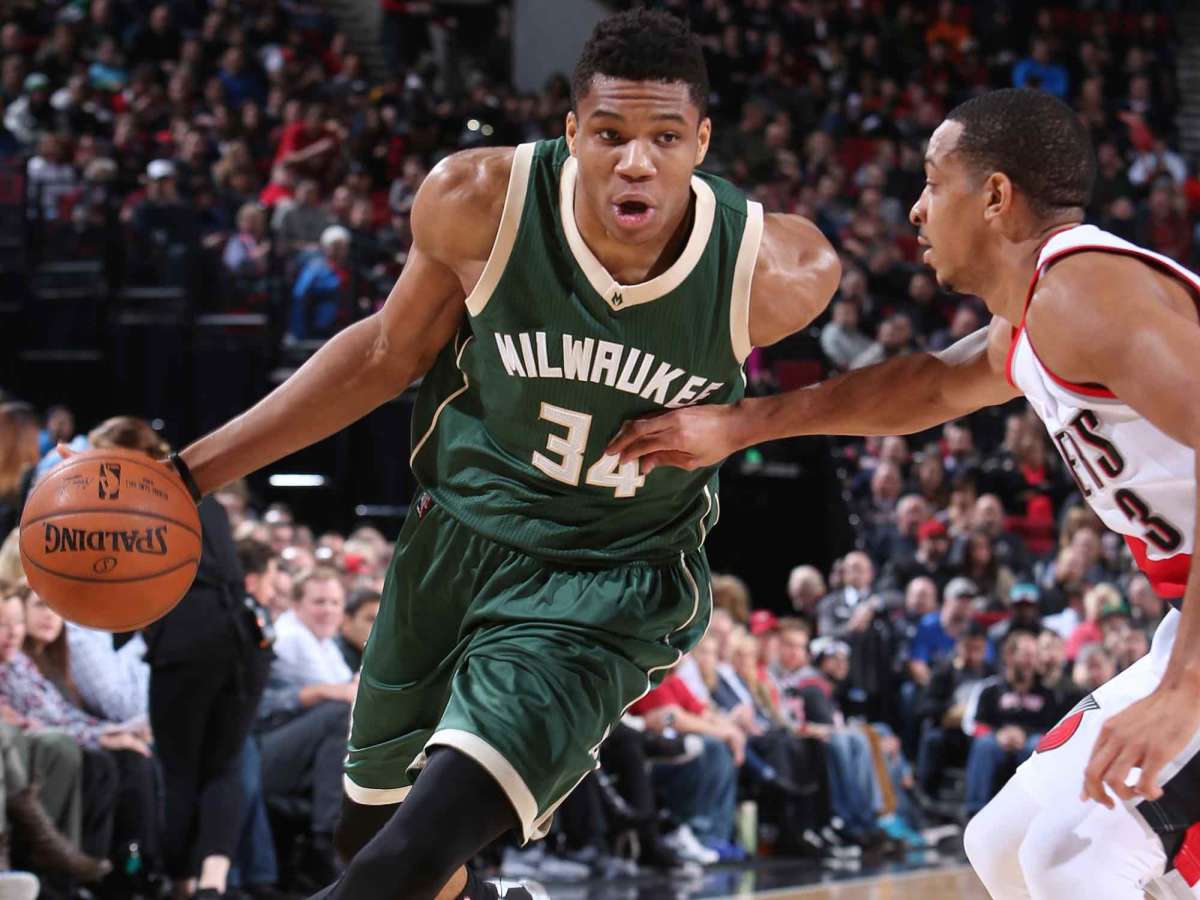Giannis Antetokounmpo: The Most Intriguing Point Guard In NBA History

This story appears in the Jan. 9, 2017 issue of SPORTS ILLUSTRATED. To subscribe, click here.
On the worst nights, when the fadeaways are short and the pocket passes are late, Giannis Antetokounmpo skips the showers. He storms out of the Bradley Center in full uniform, from home locker room to player parking lot, and hops into the black Explorer the local Ford dealer lent him. He turns right on North 4th Street in downtown Milwaukee, steers toward the Hoan Bridge and continues six miles south to the Catholic seminary in St. Francis, where the priests pray and the Bucks train and The Freak dispenses his rage. Alone, Antetokounmpo reenacts the game he just played, every shot he clanked and every read he missed. Sometimes, he leaves by 1 a.m. Other times, he stays until three, sweating through his white jersey for a second time. “I get so mad, and if I go right home, I’m afraid I’ll never get that anger out,” Antetokounmpo says. “This is how I get the anger away.”
He used to administer his form of self-flagellation on the court, because that’s what he saw Chris Paul do after a Clippers loss in L.A. But he noticed some fans lingering in the lower bowl with their cellphone cameras and he didn’t want anybody to think he was putting on a show. So he retreats, in space and time. Here he is not the $100 million man with the catchy nickname and the barrel chest who studies Magic Johnson’s fast breaks and Russell Westbrook’s mean mugs, who wrestles LeBron and mimes Dirk, who hears MVP chants and references 40-balls. Here he is not even the spring-loaded first-round pick who arrived wide-eyed in the United States three and a half years ago, tweeting breathlessly about his first smoothie, refusing to use the auto-pump feature on his gas nozzle because he was so excited to pump it himself, chirping after a burger at In-N-Out in Westwood Village: “This is America right here! The real America! Isn’t it beautiful?”
No, here he is the lanky hustler from Athens, peddling watches, sunglasses, toys and video games, on the streets near the Acropolis while his parents feared that police would demand their papers and deport them back to Africa. Much of his backstory has been told, how Charles and Veronica Antetokounmpo emigrated from Nigeria to Greece in 1991 for a better life, had four boys there, and bounced from one eviction notice to another. But the further Giannis gets from his childhood, the more it resonates, in different ways. “I can’t push it to the side,” Antetokounmpo explains. “I can’t say, ‘I’ve made it, I’m done with all that.’ I will always carry it with me. It’s where I learned to work like this.” He could sell all day, serenade tourists with Christmas carols at night, and return home without enough cash for dinner. Still, he laments, “The results were never guaranteed.” Therein he finds the biggest difference between his life then and now. “If I work here,” he says, “I get the results. That’s the greatest feeling ever for me.” It keeps him coming back to the gym—straight from the arena after losses, straight from the airport after road trips, straight from the bed after back-to-backs.
Antetokounmpo stands 6' 11", with legs so long opposing coaches constantly complain that he is traveling, until they review the tape. “He’s not,” says Wizards coach Scott Brooks. “It’s just that we’ve never seen somebody with a stride like this.” Among the NBA’s legion of stretchy giants, Kevin Durant is the scorer, Anthony Davis the slasher. Antetokounmpo is the creator, traversing half the court with four Sasquatch steps, surveying traffic like a big rig over smart cars. Durant and Davis try to play point guard. Antetokounmpo actually does it, dropping dimes over and around defenders’ heads, leading the Bucks in every major category; 23.8 points, 8.9 rebounds, 5.9 assists, 2.0 blocks and 2.0 steals. This season he will be the team's first All-Star since Michael Redd in 2004, and before you learn to spell his surname, he will be much more.

Growing up, his customers occasionally mentioned his cartoonishly long limbs, but he shrugged. He didn’t need a 7' 3" wingspan. He needed a sucker to buy those knockoff shades. He viewed himself less as The Greek Freak than a Greek grinder. “I didn’t really look at my body and think about what it meant,” Antetokounmpo says. “I didn’t figure it out.” He glances down at his 12-inch hands, bigger than Kawhi Leonard’s, bigger than Wilt Chamberlain’s. He finally knows those names. “A lot of players will tell you, ‘When I was a kid, I watched Kobe Bryant, Michael Jordan, LeBron, Magic, and I wanted to be just like them,’ ” Antetokounmpo says. “For me it wasn’t like that at all.” He laughs, because at last he grasps the magnitude of his gifts and the ways they can be unleashed. He understands that a 22-year-old with his build and his drive should never go home hungry again.
Antetokounmpo lives in a modest three-story townhouse near Saint Francis de Sales Seminary, in the same complex as his parents. Like any hoop phenom, he subsists on Wingstop and NBA TV. But when he needs to steady himself amid his unimpeded ascent, he heads west to Omega restaurant, where 24 hours a day he can order gyros and lamb chops with sides of nostalgia and perspective. “I think about where I was four years ago, on the streets, and where I am today, able to take care of my kids and my grandkids and their grandkids,” Antetokounmpo marvels. “I’m not saying that in a cocky way or a disrespectful way. But it is a crazy story, isn’t it?”
On March 28, 2013, Bucks general manager John Hammond sat in a dining room at the Bradley Center before a game against the Lakers and explained why his team could not acquire a superstar. Hammond was in his fifth season, with a record of 181–206, never good enough to contend and never bad enough to tank. The stars he had brought to Milwaukee, if you can call them that, were Brandon Jennings, Monta Ellis, John Salmons and Carlos Delfino. Hammond outlined the two most obvious ways to land a prospective headliner: Finish on the fringe of the lottery and turn a lucky Ping-Pong ball into the first overall draft pick, which has about a 1.8% chance of occurring. Or pitch a premier free agent on a small market with a frigid climate and a mediocre roster, which comes with even steeper odds.
At the end of an otherwise dispiriting conversation, Hammond mentioned casually that he was leaving town the next day. “Where are you going?” I asked.
“Greece,” he said.
Memories of the trip have become blurred in the recounting: Antetokounmpo’s coach, idling outside the gym on a scooter, smoking a cigarette; Antetokounmpo’s teammates, nearly twice his age, coming straight to pregame warmups from their day jobs; Antetokounmpo’s parents, sitting high in the stands, as their beanstalk son deftly ran the point for Filathlitikos in the Greek second division. Hammond flashed back to a line that coach Larry Brown once told him. “For some people the game goes 110 miles per hour. For others, it goes 70.” Afterward Antetokounmpo’s Greek agents drove Hammond through Athens. “I don’t know what’s going to happen to this guy,” the GM said from the backseat. “But his life is about to change in a major way.”
The 18-year-old Antetokounmpo was no secret among scouts, but many organizations were scared to draft him, given that he couldn’t even score an invitation to the Nike Hoop Summit. But Hammond, desperate for that elusive star, was ready to take a risk. The Bucks picked Antetokounmpo 15th overall in 2013, recognizing that there is yet another way to secure a difference-maker: Steal him.
The day after the draft Antetokounmpo walked out of the elevator at The Pfister Hotel in downtown Milwaukee, where former Wisconsin senator and Bucks owner Herb Kohl was coincidentally sitting in the lobby coffee shop. Antetokounmpo was self-conscious about his broken English, but Kohl’s top lieutenant, JoAnne Anton, happened to be fluent in Greek. “I remember how his eyes lit up when he heard her voice,” Hammond recalls. “It was a small thing, but you couldn’t help but think, ‘Maybe this is meant to be.’”
So began an endearing affair between Antetokounmpo and Milwaukee. He moved into a two-and-a-half-bedroom apartment in St. Francis that he shared with his parents and younger brothers, Kostas and Alex. Bucks guard O.J. Mayo sent him a U-Haul filled with furniture. Caron Butler and Zaza Pachulia helped him pick out clothes for road trips. Hammond and assistant general manager David Morway taught him to drive, parallel parking on the seminary grounds, and assistant video coordinator Ross Geiger lent him his maroon Subaru Outback Legacy. Geiger was Antetokounmpo’s best friend in Milwaukee, the one who oversaw his graduation from EDM to hip-hop, and instructed him on which lyrics he could sing in public and which he could not. But when they ate dinner, even at McDonald’s, Antetokounmpo insisted on splitting the bill. Either he didn’t comprehend how much more he earned than a video guy, or he couldn’t bear to part with the cash.
Milwaukee went 15–67 in Antetokounmpo’s rookie season, which dampened his enthusiasm not a bit. He memorized lines from Coming to America and Next Friday. He learned to throw a football with Morway’s sons, Michael and Robbie. He begged teammates to play the shooting game two-for-a-dollar that he picked up from power forward John Henson. When a Greek TV station came to visit, he told Geiger they would need a customized handshake, “so we look like we know what we’re doing.” The Bucks were brutal, and The Greek Freak averaged only 6.8 points, a reserve small forward who spent most of his time marooned in the corner, probing for open spaces and put-back dunks. But he provided highlights and hope. “I love Milwaukee!” Antetokounmpo told teammates over lunch at the facility one day. “I’m going to be in Milwaukee 20 years! I’ll be here so long they’ll be sick of me!” He feared that somebody would wake him from his dream and send him home. “That they’d take it all away from me,” he says.

To Bucks vets, Antetokounmpo supplied comic relief during a dismal winter, but Geiger sensed he was capable of more. One night they were watching a game on television when Antetokounmpo shouted, “Whoa! Did you see that?” Geiger hit rewind. Antetokounmpo was always amazed he could rewind live TV. “There it is!” Antetokounmpo yelped. “Look at the action on the help side and how that opens up the whole play!” Another night Geiger invited him to dinner at a friend’s house and Antetokounmpo barely uttered a word. On the way home, he told Geiger, “You’re really close with Erik, but you’re not that close with Matt.”
“He was right,” Geiger says. “He knows how to read people and situations. That’s because of how he grew up. He couldn’t waste his time selling you something for five minutes if you weren’t going to buy. He had to read body language and move on.”
When Antetokounmpo reminisces about his rookie year, he sounds as if he is talking about another era and another person. “I was like a kid in the park, seeing all the cities, seeing LeBron and KD, having so much fun. But that kid—the kid with the smoothies—I’m not really that kid anymore.”
Pro sports age everybody. There was the night in his first season when Antetokounmpo’s agent at Octagon, Alex Saratsis, told him that a Bucks assistant coach believed he wasn’t working hard enough. “You can tell me I’m not playing well,” Antetokounmpo replied, tears in his eyes. “You can tell me I’m not doing the right things. But you cannot tell me this. I won’t accept it.” And there was the night in his second season when the Bucks’ new head coach, Jason Kidd, banned him from shooting three-pointers. “I want to shoot threes,” Antetokounmpo argued. “How can I not shoot threes?” Geiger left for the Suns. Morway went to the Jazz. Nate Wolters, Antetokounmpo’s best friend on the team, was waived. “I didn’t know all that would happen,” Antetokounmpo says. “You build these relationships, know these people, and then all of a sudden you get a text in the summer: ‘I’m not coming back.’ What? You get mad. You learn this is a business.”
The first time Kidd benched him, Antetokounmpo was irate. “I was like, ‘Let’s see what this guy did in his career, anyway,’ ” Antetokounmpo recounts, and called up Kidd’s bio on his phone. “I saw Rookie of the Year, NBA championship, USA Olympic gold medal, second in assists, fifth in made threes, blah, blah, blah. I was like, ‘Jesus freaking Christ, how can I compete with that? I better zip it.’ ”
At 6' 4", Kidd is one of the best point guards who ever lived. “But I wanted so badly to be 6' 7" or 6' 8",” Kidd says. “Guys like Magic are looking through a window that’s so high. They can make passes I could only dream about.” He detected enough playmaking ability from Antetokounmpo to try him at point guard in the 2014 summer league and again in the ’15 preseason, but he wasn’t satisfied with the results. Last Feb. 20 in Atlanta, with the Bucks 11 games under .500 and Michael Carter-Williams coming off the bench, Kidd put the ball in Antetokounmpo’s massive mitts. “We didn’t talk about it,” Kidd says. “We didn’t make a big deal out of it. There was no pressure. We just wanted to try something different.”
The Bucks won that night in double overtime as Antetokounmpo had 19 points and three assists, and afterward Kidd embarked on an audacious experiment: building the biggest point guard anybody can remember. Kidd oversees the project, but assistant coach Sean Sweeney runs it, accompanying Antetokounmpo to his midnight workouts, deconstructing his pick-and-rolls, furnishing him with clips of Magic but also less predictable influences such as Kiki Vandeweghe’s post moves and Shawn Kemp’s transition dunks. Antetokounmpo hung a photo of himself, facing up against the Raptors, in Sweeney’s office. Sweeney has repeatedly taken the picture down, but somehow, it always returns. “Don’t forget about me!” Antetokounmpo sings.

This summer they worked out twice a day for two-and-a-half weeks at Long Beach State’s Walter Pyramid, picking strangers out of the bleachers to fill fast breaks. “It was an inordinate amount of time going through situations,” Sweeney says. “We’d start with the running game. ‘First look is to the big running to the rim. Next look is up the side to the wing. Next look is across the side. Now can you get it and go full speed? Now you can get it and go and pitch it back to a trailer who can shoot?’ ”
“You know what I liked about using all those strangers?” Kidd adds. “He had to speak. You don’t know these people, but you have to tell them what to do. They’re looking at you for direction and you have to give it to them. That’s what a point guard does. He has to know his teammates better than they know themselves.”
NBA Power Rankings: One-Man Shows Take Center Stage
The Bucks acquired Matthew Dellavedova in July and made him their de facto floor general, but Giannis is the one making the decisions and feeling the consequences. “If this guy gets the ball five times, I know he’s happy, and if that guy gets it once, I know he’s not,” Antetokounmpo groans. “So I’m like, ‘Oh, man, I’ve got to get that guy the ball.’ It’s hard to satisfy everybody.”
Actually, it’s impossible, which is another of the lessons Kidd is imparting. There are things stars do, like pick up the bill at McDonald’s, and things they don’t, like placate everyone in their presence. “To make the next step, I’ve learned you need a little cockiness inside you,” Antetokounmpo says. “I can be a little cocky.” As a rookie, he jawed with Carmelo Anthony. In his second season, he body checked Mike Dunleavy. But the Bucks have been seeing his snarl more often of late, after pep talks from Kobe Bryant last season and Kevin Garnett last month, as well as daily skull sessions with veteran Bucks guard Jason Terry. “I’ll tell him something at a timeout like, ‘Watch the curl, and if the curl isn’t there, the slip will be wide open,’ ” says Terry. “And he’ll always tell me, ‘I got you, bro.’ ” He searches for the slightest edge, because a highlight a night is not enough anymore. He needs 25/12/8 with a win. “I’ve definitely become more serious,” Antetokounmpo says. “I have a franchise on my shoulders.”
On 28-And-a-half acres around the Bradley Center, the Bucks are constructing a new practice facility that will open later this year and a new arena that will open next year. Next to the site is a billboard, featuring Antetokounmpo’s muscled back, over the slogan the future looks strong. Hammond, it turns out, proved himself wrong, and possibly twice. He found a star, and he might have snagged another, drafting forward Jabari Parker second in 2014. The Bucks currently sit seventh in the East, but outside of Cleveland, their long-term outlook is as bright as anybody’s.
Hammond and Antetokounmpo talk often, though no longer about the perils of right turns on red. “He’s trying to figure this whole thing out, what he’s going to be,” Hammond says. “We’re seeing this more focused side of him, but it’s a fine line. You still want to enjoy the game, the fun part of it.” His trust is difficult to earn. Private trainers with renowned NBA clients offer to work with Antetokounmpo every summer. He turns them all down, sticking with Bucks staffers.
“Because my parents were illegal, they couldn’t trust anybody,” Antetokounmpo says. “They were always nervous. A neighbor could be like, ‘These people are making too much noise, their children are making too much noise,’ and the cops could knock at our door and ask for our papers and that’s it. It’s that simple. So you’re always a little closed. I’m outgoing when I feel comfortable, but it took me 21 years just to invite a girl to meet my friends. I’m closed too.”
The Crossover's 10 Best NBA Stories Of 2016
Around familiar faces, like his live-in girlfriend, his innocence is impossible to extinguish. When Saratsis mentions the All-Star Game, Antetokounmpo hushes him, so as not to jinx it. When Geiger visits, Antetokounmpo hands him the Wingstop menu, with the addendum, “I’m buying!” And when Kostas left home for the University of Dayton this fall, big brother drove six hours to move him into his dorm, stopping only at Wal-Mart. “Here is Giannis at midnight, with 80% of the freshman class, walking up and down the hallway carrying bedsheets,” recalls Dayton coach Archie Miller.
Giannis functions as the family patriarch, with his father adjusting to the United States and his older brother, Thanasis, playing in Spain. When Giannis inked his four-year, $100 million extension in September—after postponing the signing by four hours to accommodate a morning workout—he called Bucks co-owner Wes Edens at his hotel in Ireland. “I just wanted to say thank you for the money,” Antetokounmpo started. “It means so much to me and my family. I’m going to work very hard for it.” Then he offered to buy friends and family steak at the Capital Grille in Milwaukee for lunch. When the meat arrived, with appetizers and side dishes, Giannis looked alarmed. “I don’t know who’s paying for all this,” he cracked, “because I only said I’d get the steak.”

Three months later he walks into the practice gym the morning after a home-and-home with the Cavaliers, 76 minutes in close proximity to LeBron James. “You feel different after you play him,” Antetokounmpo reports. “Your legs, your body, you’re sore everywhere. Sometimes you have to lie to yourself, lie to your mother: ‘Yeah, I’m good, I’m good.’ ” The team has the day off. “But where else do I have to be?” he asks. He plays two-on-two. He shoots along the arc with Sweeney. Rookie Thon Maker mops the floor. Antetokounmpo's three-point percentage, 29.3 this season, right around his career mark, is still the source of much consternation. Judging by his practice sessions, it will spike soon, and then there won’t be any way left to defend him. “When I’m coaching,” muses the 39-year-old Terry, “he’ll be pretty much unguardable.”
The next night, against Washington, Antetokounmpo starts the game with a reverse layup, a midrange pull-up, a pair of sweeping hooks and finger rolls. The Wizards can’t keep him out of the lane or off the free throw line. He dunks off a Eurostep, a lob, a back-cut and a put-back. He dunks over Kelly Oubre, Otto Porter and Markieff Morris, flexing as they wince. When Morris fouls him hard on a breakaway, Antetokounmpo sprints over to ask him about it. He has 24 points in the first half, Milwaukee has 73, and the Cream City Clash in Section 222 chant: “Can’t Stop Gian-nis!” He looks as long as Durant, as strong as Davis, as ferocious as Westbrook. He’s got Dirk’s fadeaway, with the right knee raised, and a nifty two-handed scoop all his own.
He finds Parker for a dunk and a layup, Henson for a layup, Dellavedova for a short J. Leading the break, he whips a pass to Terry in the corner for three. I got you, bro. In the post he backs down a trio of Wizards and kicks out to Malcolm Brogdon for another three. With 6:26 left he stands on the free throw line, and the locals break out a rare MVP chant. He has a career-high 39 points. He craves the 40-ball. He tries to settle himself, but the second free throw rims out, and Kidd calls him to the bench. The Bucks lead by 27, which will be their final margin. He winks at Alex, his youngest brother, behind the courtside seats.
In the locker room afterward, players scatter for Christmas, two days away. “Stay out of the gym!” swingman Tony Snell cautions, and Antetokounmpo surreptitiously shakes his head. “I don’t know,” he mutters. A few minutes later the black Explorer turns right on North 4th Street, toward the snow-covered bridge, taking the league’s most unlikely driver to a place only he can see.
